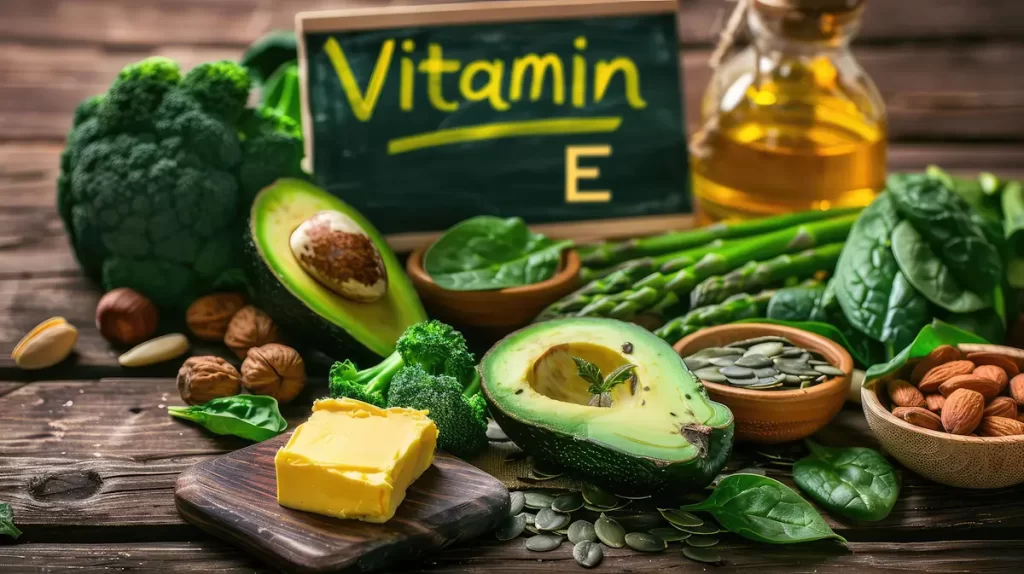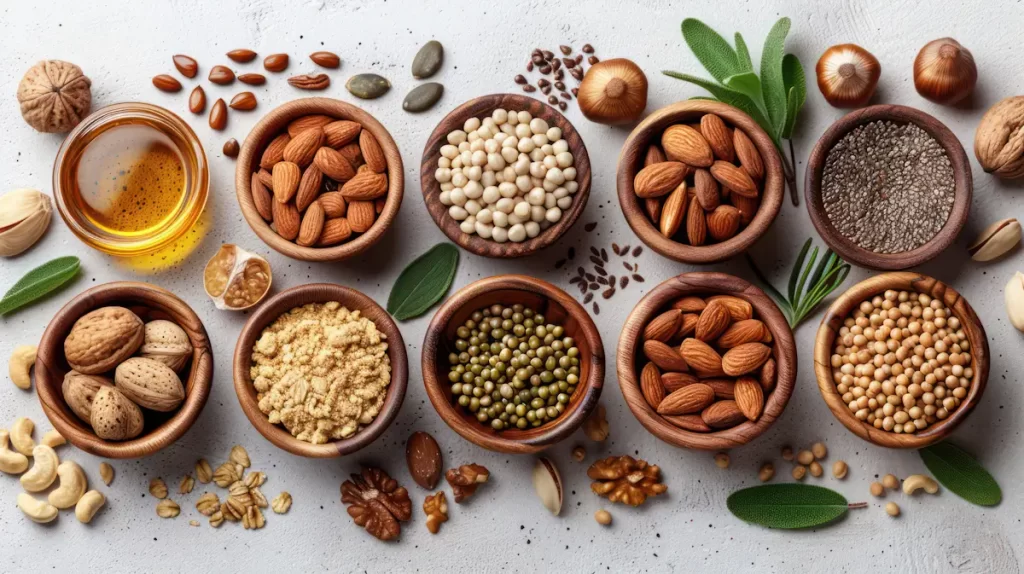Feeling tired or worried about your health? Vitamin E might be the answer you’re missing. It’s a fat-soluble vitamin that protects your cells from damage and keeps your body strong.
Thank you for reading this post, don't forget to subscribe!This blog will explain its benefits, sources, and how it impacts your health. Keep reading—you’ll want to know this!
Key Takeaways
- Vitamin E is a fat-soluble vitamin that fights free radicals, supports immunity, and improves skin health. Sources include sunflower seeds, almonds, spinach, and wheat germ oil.
- Adults need 15 mg of vitamin E daily; lactating women require 19 mg. Wheat germ oil provides over 135% of the recommended daily value per tablespoon.
- High doses above 1,000 mg/day can increase bleeding risks and interfere with medications like warfarin. Safe intake is crucial to avoid harm.
- Studies link higher vitamin E intake with reduced oxidative stress but show mixed results for heart disease or cancer prevention benefits (Nutrients journal review, July 25, 2023).
- New supplement forms like mixed tocopherols improve absorption for those with conditions like Crohn’s disease or nutrient deficiencies.
The Fundamental Role of Vitamin E
Vitamin E helps protect your cells from damage caused by free radicals. It also plays a key part in keeping your body strong and healthy.
Antioxidant properties
Antioxidants block free radicals from damaging cells. These harmful molecules form during normal metabolism or from external sources like UV rays and cigarette smoke. Over time, this damage can lead to diseases like heart disease, cancer, or vision loss such as age-related macular degeneration (AMD).
Vitamin E acts as a shield against oxidative stress by neutralizing these free radicals before they harm important body tissues.
This fat-soluble vitamin plays a key role in protecting cell membranes. Foods rich in natural vitamin E, like sunflower seeds and green leafy vegetables, offer excellent sources of this nutrient.
Many people also use antioxidant supplements for added support. Studies suggest that reducing oxidative stress may lower the risk of cardiovascular disease and certain cancers while promoting overall health.
Oxidative stress is at the root of many chronic diseases.
Immune system support
Vitamin E plays a key role in boosting immune function. It supports the body’s ability to fight off infections by protecting cells from damage caused by free radicals. Alpha-tocopherol, a form of Vitamin E, also helps regulate gene expression and cell signaling—processes critical for immunity.
This fat-soluble vitamin enhances T-cell function, which is vital for defending against harmful pathogens. People with conditions like celiac disease or Crohn’s disease may face higher risks of deficiency, weakening their immune response.
Including natural sources like green leafy vegetables or fortified foods can help maintain adequate intake levels and support overall health.
Skin health enhancement
It helps protect skin cells from damage caused by free radicals and oxidative stress. This reduces signs of aging, like wrinkles and dryness. Its role in skin repair also promotes faster healing of small wounds or scars.
Sunflower seeds, wheat germ oil, and green leafy vegetables are rich sources that nourish the skin.
It improves blood circulation by increasing prostacyclin release. Better blood flow supports healthier, glowing skin. As a fat-soluble vitamin found in nuts and vegetable oils, it keeps skin hydrated while protecting it from harmful UV rays when used in sunscreen products too.

Recommended Daily Intakes of Vitamin E
The amount of vitamin E you need each day depends on your age and life stage. It’s crucial to ensure you’re getting enough, whether through food or supplements, to support overall health.
Adults and children
Adults need 15 mg of vitamin E daily to maintain good health. This amount supports the immune system and helps fight free radicals. For lactating women, the requirement increases slightly to 19 mg.
Children have lower needs based on their age. Infants from birth to six months should get 4 mg, while seven- to twelve-month-olds require 5 mg.
As kids grow, their needs go up too. Those aged one to three years need 6 mg daily, four- to eight-year-olds need 7 mg, and nine- to thirteen-year-olds require about 11 mg per day.
Adolescents starting at fourteen years old should aim for the same as adults—15 mg daily—to help with growth and development.
Meeting these recommendations ensures strong immunity and healthier bodies.
Special considerations for pregnant or nursing women
Pregnant women need 15 mg of vitamin E daily, while nursing mothers require more—19 mg per day. This increase supports the baby’s growth and helps protect cells from oxidative stress.
Good sources include green leafy vegetables, sunflower seeds, and wheat germ oil.
High doses can pose risks during pregnancy or affect milk quality while breastfeeding. Stick to food-based sources instead of supplements unless advised by a doctor. Vitamin E is fat-soluble, so balance with healthy fats like vegetable oils for better absorption.
Dietary Sources of Vitamin E
Vitamin E is found in various foods and can also come from fortified options or supplements. Eating a mix of these sources helps maintain good health and supports your body’s needs.
Natural food sources
Wheat germ oil stands out with 20.3 mg of vitamin E per tablespoon, covering 135% of your daily value (DV). Sunflower seeds offer 7.4 mg in a one-ounce serving, which is about 49% DV.
Almonds deliver slightly less, at 6.8 mg per ounce or 45% DV.
Sunflower oil gives you around 5.6 mg per tablespoon—equal to 37% DV. Safflower oil adds another option with its content of about 4.6 mg (31% DV). Hazelnuts provide a solid source too; one ounce contains approximately 4.3 mg, meeting roughly 29% of your daily needs….
Fortified foods
Fortified cereals provide a reliable source of vitamin E. Many brands include it to help people meet their daily nutrient needs. These options are especially helpful since most Americans consume less vitamin E than the recommended dietary allowance (RDA).
Nutrition Facts labels show vitamin E content in milligrams, thanks to FDA updates on labeling rules. The Dietary Guidelines for Americans suggest getting vitamins through food sources, including fortified foods, rather than supplements.
Supplements
Vitamin E supplements come in natural and synthetic forms. Natural vitamin E, often labeled as “d-alpha-tocopherol,” is absorbed better by the body than synthetic versions like “dl-alpha-tocopherol.” They are available in soft gels, capsules, and liquid drops.
Many mixed tocopherols include other forms of vitamin E to boost effectiveness.
Supplements can help people with certain conditions like Crohn’s disease or cystic fibrosis, who may struggle to absorb fat-soluble vitamins. Pregnant women and those breastfeeding might also need additional support if their dietary intake is low.
But too much vitamin E—especially over 1,000 mg per day—can increase risks of bleeding issues or interfere with medications like blood thinners such as warfarin (Coumadin). Always check labels for international units (IU) or milligrams (mg) to avoid excessive intake.

Vitamin E Deficiency
Vitamin E deficiency can cause serious problems, like weak muscles and nerve issues—read on to learn who is at risk and how to prevent it.
Signs and symptoms
Muscle weakness can develop due to nerve and muscle damage. Vision problems, such as blurred vision or difficulty seeing in low light, may also arise. Impaired immune response increases the risk of infections.
Peripheral neuropathy is another concern. This condition affects nerves outside the brain and spinal cord, causing tingling or numbness in hands and feet. Retinal degeneration might lead to further vision loss over time if not addressed promptly.
Risk groups
Certain groups face a higher risk of vitamin E deficiency. People with conditions like Crohn’s disease or cystic fibrosis may struggle to absorb fat, which affects vitamin E levels since it’s a fat-soluble nutrient.
Premature babies are also at risk because their bodies lack enough reserves.
Adults on very low-fat diets can miss out too. Those taking medications that hinder fat absorption, such as weight-loss drugs, might experience reduced vitamin E intake. Early diagnosis helps manage these risks and prevent related health issues like nerve damage or immune system problems.
Managing and preventing deficiency
A vitamin E deficiency can cause health problems. Taking steps to manage and prevent it is important for overall well-being.
- Eat foods rich in natural vitamin E like sunflower seeds, almonds, and spinach. Add wheat germ oil or vegetable oils to your meals for an extra source of this nutrient.
- Include fortified foods such as cereals and milk in your diet. These are often enriched with vitamin E to help meet daily needs.
- Take dietary supplements if recommended by a doctor. Use the correct dosage to avoid excessive intake risks.
- Focus on balanced nutrient intakes by following guidelines like MyPlate. This ensures proper levels of other vitamins like A, C, and K.
- Monitor health conditions like Crohn’s disease as they may lower vitamin absorption. Consult healthcare providers for personalized advice.
- Check special requirements during pregnancy or breastfeeding. A healthy dietary pattern supports the needs of both mother and baby.
- Avoid prolonged low-fat diets that limit fats needed for vitamin E absorption. Healthy fats help transport this important nutrient.
- Support protection against cell damage by reducing oxidative stress from free radicals through consuming antioxidant-rich foods paired with vitamin E sources.
- If you experience symptoms of deficiency like muscle weakness or vision issues, seek medical advice immediately.
- Stay informed about dietary reference intakes (DRIs) set by the Food and Nutrition Board to maintain optimal levels throughout life stages.
Health Benefits of Vitamin E
Vitamin E helps shield cells from harm caused by oxidative stress. It also supports your body in staying strong and well, improving overall health.
Cardiovascular health
Higher vitamin E intake may lower coronary heart disease (CHD) risk by 30%-40%, according to observational studies. It helps combat oxidative stress, which damages the heart and blood vessels.
This nutrient supports healthy blood flow and can reduce inflammation tied to cardiovascular diseases.
Large-scale trials show mixed results for preventing major cardiovascular events like heart attacks and strokes. While some groups benefit, others see little change. Excessive doses of synthetic vitamin E could lead to hemorrhagic stroke due to its effect on thinning blood.
Regularly eating nuts, seeds, or wheat germ oil provides natural support without these risks.
Eye health, including protection against cataracts
Protecting eyes is another benefit of vitamin E. Studies like AREDS and AREDS2 showed a 25% drop in advanced age-related macular degeneration (AMD) risk with daily supplements containing vitamin E, along with other nutrients.
This condition causes vision loss over time, especially in older adults.
For cataracts, evidence on vitamin E’s effects is less clear. Data shows no strong impact on slowing or stopping the progression of this cloudy lens issue. Eating foods rich in vitamin E—like sunflower seeds and wheat germ oil—still promotes overall eye health by fighting oxidative stress caused by free radicals.
Cognitive function and neurological benefits
Good eye health isn’t the only benefit of vitamin E. This powerful antioxidant also supports brain health and may help slow neurological decline. Studies suggest taking 2,000 IU of vitamin E daily could reduce functional decline in Alzheimer’s patients.
It may protect brain cells from damage caused by free radicals and oxidative stress.
However, most research shows little cognitive improvement for healthy people or those with mild memory issues when using supplements. Natural sources like sunflower seeds or wheat germ oil remain better choices to maintain balance and promote overall mental well-being.
Skin protection and repair
Vitamin E helps protect skin from UV damage. It reduces erythema, which is the redness caused by sun exposure. Applying it topically can boost the skin’s vitamin E levels. This shields against harmful free radicals that lead to aging and damage.
Its anti-inflammatory effects calm irritated or inflamed skin after sunburns. This repair process supports healing while improving overall skin health. Sunflower seeds and wheat germ oil are rich sources that help maintain these protective benefits naturally.
Vitamin E in Disease Prevention and Management
Vitamin E plays a role in reducing risks and managing conditions such as heart disease, Alzheimer’s, and even certain types of arthritis. Dive deeper into how it helps support your health….
Cardiovascular diseases
High dietary intake of natural vitamin E links to lower rates of cardiovascular disease (CVD), according to observational studies. This suggests its role in reducing oxidative stress, which damages arteries and increases heart problems.
Despite this, controlled trials have not shown that vitamin E supplements significantly reduce major cardiovascular events in the general population.
Heart health benefits might still exist for some groups or specific conditions. It may help decrease inflammation and improve blood vessel function when paired with other nutrients like vitamins C and beta carotene.
The impact varies by individual factors like diet, age, or existing illnesses—making balanced meals rich in antioxidants critical for overall cardiovascular support. Adjusting daily habits can aid eye protection next….
Alzheimer’s Disease
A healthy heart can support brain function, but vitamin E may play a direct role in Alzheimer’s Disease. Studies suggest taking 2,000 IU of vitamin E daily could slow functional decline in patients with mild to moderate Alzheimer’s.
It works by fighting oxidative stress, which damages brain cells over time.
This nutrient’s antioxidant properties protect neurons from free radicals. These harmful molecules contribute to cognitive issues and neurodegenerative diseases like Alzheimer’s.
Including natural vitamin E sources—like sunflower seeds or wheat germ oil—in your diet may help maintain brain health as you age.
Photodermatitis
Alzheimer’s Disease affects the brain, while photodermatitis harms the skin. Photodermatitis is a condition where UV rays trigger skin inflammation. Vitamin E helps reduce this damage due to its anti-inflammatory properties.
Applying it to the skin may lessen redness and irritation caused by UV light.
Topical use of Vitamin E boosts skin defense against sunlight. It can protect cells from oxidative stress caused by free radicals after sun exposure. This benefit makes it helpful for managing conditions like erythema or severe sunburns linked to photodermatitis.
Rheumatoid arthritis
Rheumatoid arthritis (RA) impacts joint health and causes inflammation. Vitamin E’s antioxidant effects may reduce oxidative stress, which contributes to RA. It neutralizes free radicals that damage tissues.
A study with 39,144 female health professionals found no strong link between vitamin E intake and lower RA risk (RR: 0.89). Over ten years, only 106 confirmed cases of definite RA were noted.
This shows the possible limits of vitamin E in preventing or managing the condition.

Potential Risks and Considerations
Too much vitamin E can lead to health problems, like bleeding issues. It may also interact with certain medications or affect medical procedures.
Excessive intake concerns
High doses of vitamin E, especially above 1,000 mg/day, can cause serious risks. These include hemorrhage and problems with blood clotting. The Tolerable Upper Intake Level (UL) for adults is 1,000 mg per day—equal to about 1,500 IU for natural forms or 1,100 IU for synthetic ones.
Taking too much through supplements may interfere with medications like blood thinners. This increases bleeding risk. It can also impact surgeries by slowing wound healing due to its effects on coagulation.
Always check labels on fortified foods and supplements to avoid exceeding safe limits unintentionally.
Interactions with medications
Vitamin E can affect certain medications. For example, it may increase the risk of bleeding if taken with blood-thinning medications like warfarin. People on these drugs should talk to their doctor before using vitamin E.
Large doses of vitamin E might also interfere with some cholesterol-lowering treatments. Studies show that combining high amounts of this vitamin with simvastatin and niacin could reduce HDL (good) cholesterol gains.
Always check with a medical professional if you take supplements alongside prescriptions.
Impact on surgery and other medical procedures
High doses of alpha-tocopherol supplements can cause bleeding problems. They interfere with blood clotting, which is vital during and after surgery. This risk increases if combined with blood-thinning medications like aspirin or warfarin.
Doctors often advise stopping extra vitamin E before planned surgeries. It helps reduce the chance of excessive bleeding. Moving forward, it’s important to know how vitamin E interacts with other nutrients in your body!
Vitamin E and its Interaction with Other Nutrients
Vitamin E works with other nutrients, like vitamin C and vitamin K, to boost their effects and support better health—read on to discover these powerful connections!
Synergistic effects with other vitamins
Vitamin E works better when paired with other vitamins. It teams up with vitamin C to fight free radicals, reducing oxidative stress in the body. This combination helps protect cells and may lower risks of heart disease and cancer.
Vitamins A and K also interact with it. While vitamin E supports skin repair, vitamin A boosts vision health alongside it. Too much vitamin E, though, can interfere with how vitamin K helps blood clotting—leading to potential bleeding issues.
Balance is key for these nutrients to work together safely and effectively.
Impact on mineral absorption
High doses of vitamin E can interfere with mineral absorption. It may reduce the body’s ability to absorb nutrients like iron, zinc, or magnesium. This is a concern for people already at risk of deficiencies.
For example, those with Crohn’s disease or other digestive issues might face worse nutrient imbalances. Keeping intake within the recommended dietary allowance (RDA) helps avoid these problems while still gaining its benefits.
Recent Research and Developments
Scientists are exploring how vitamin E impacts diseases like Alzheimer’s and heart disease—new findings could change how we use this nutrient.
Latest studies on vitamin E benefits
An umbrella review in *Nutrients* (July 25, 2023) analyzed how vitamin E affects health. It examined links to cardiovascular disease, cancer prevention, and overall well-being. The findings showed no strong evidence proving that vitamin E can prevent heart disease or cancer.
This leaves room for further research.
Scientists continue exploring its impact on oxidative stress and free radicals. Some newer studies focus on using mixed tocopherols for better absorption and benefits. While results remain mixed, there is growing interest in its potential role with conditions like Alzheimer’s disease and type 2 diabetes.
Innovations in supplementation and absorption
New forms of vitamin E supplements aim to improve how the body absorbs and uses them. Mixed tocopherols, for example, provide a balance of natural vitamin E types rather than just one.
This helps with better antioxidant support and overall effectiveness.
Advanced delivery methods like nanoemulsions enhance absorption in people with conditions like Crohn’s disease. These innovations are especially useful for those who struggle with nutrient deficiencies or digestion issues.
Fortified foods now include improved formulations to make getting your daily recommended dietary allowance (RDA) easier too.
FAQs About Vitamin E
Many people have questions about Vitamin E—its benefits, sources, and how to use it safely… read on to clear up common doubts!
Common questions about sources
Vitamin E comes from two main sources—natural food and supplements. Natural options include sunflower seeds, wheat germ oil, almonds, spinach, and broccoli. Fortified foods like cereals also provide vitamin E.
These are good for meeting the recommended dietary allowance (RDA) of 15 mg per day for adults.
Supplements often help people with special needs or poor diets. Look for natural vitamin E on labels; it may absorb better than synthetic types. Mixed tocopherols in some products offer a range of benefits.
Always check with a doctor if combining supplements with medications like blood-thinning drugs to avoid risks.
Addressing myths and misconceptions
Some think synthetic vitamin E works just as well as natural sources. This is false. Natural vitamin E has better absorption and stronger effects in the body than synthetic versions.
Look for “d-alpha-tocopherol” on labels to ensure it’s natural.
People also worry that high doses always improve health. But taking more than 1,000 mg daily can lead to toxicity, such as hemorrhagic stroke or other issues. Stick to the recommended dietary allowance (RDA)—15 mg a day for most adults—to avoid problems.
Conclusion
Vitamin E plays a big role in keeping your body healthy. It helps fight harmful free radicals, boosts your immune system, and supports skin health. You can find it naturally in foods like nuts, seeds, and greens or through supplements.
Getting enough is key for heart health, brain function, and even disease prevention. Focus on eating a balanced diet to enjoy its many benefits!
